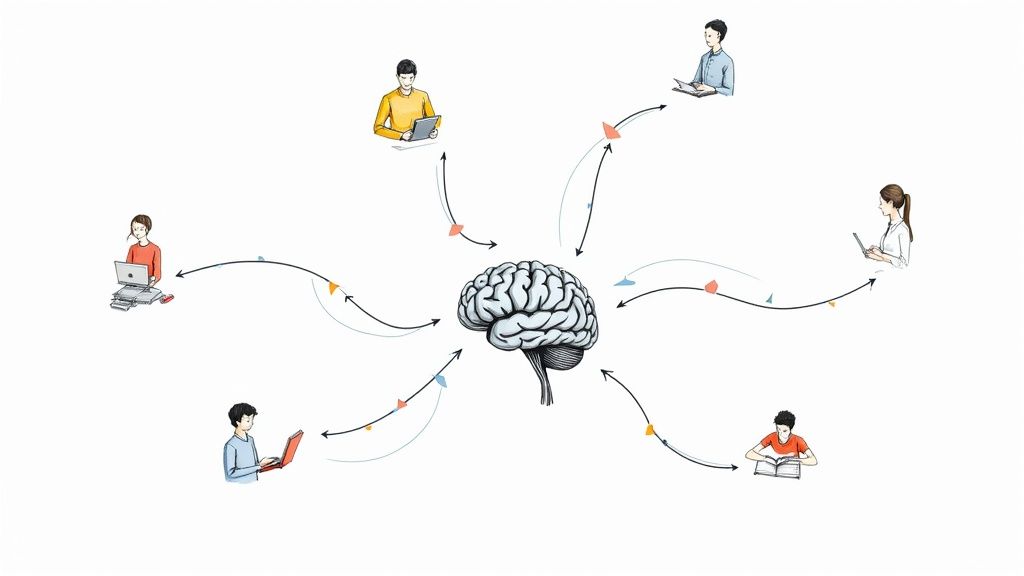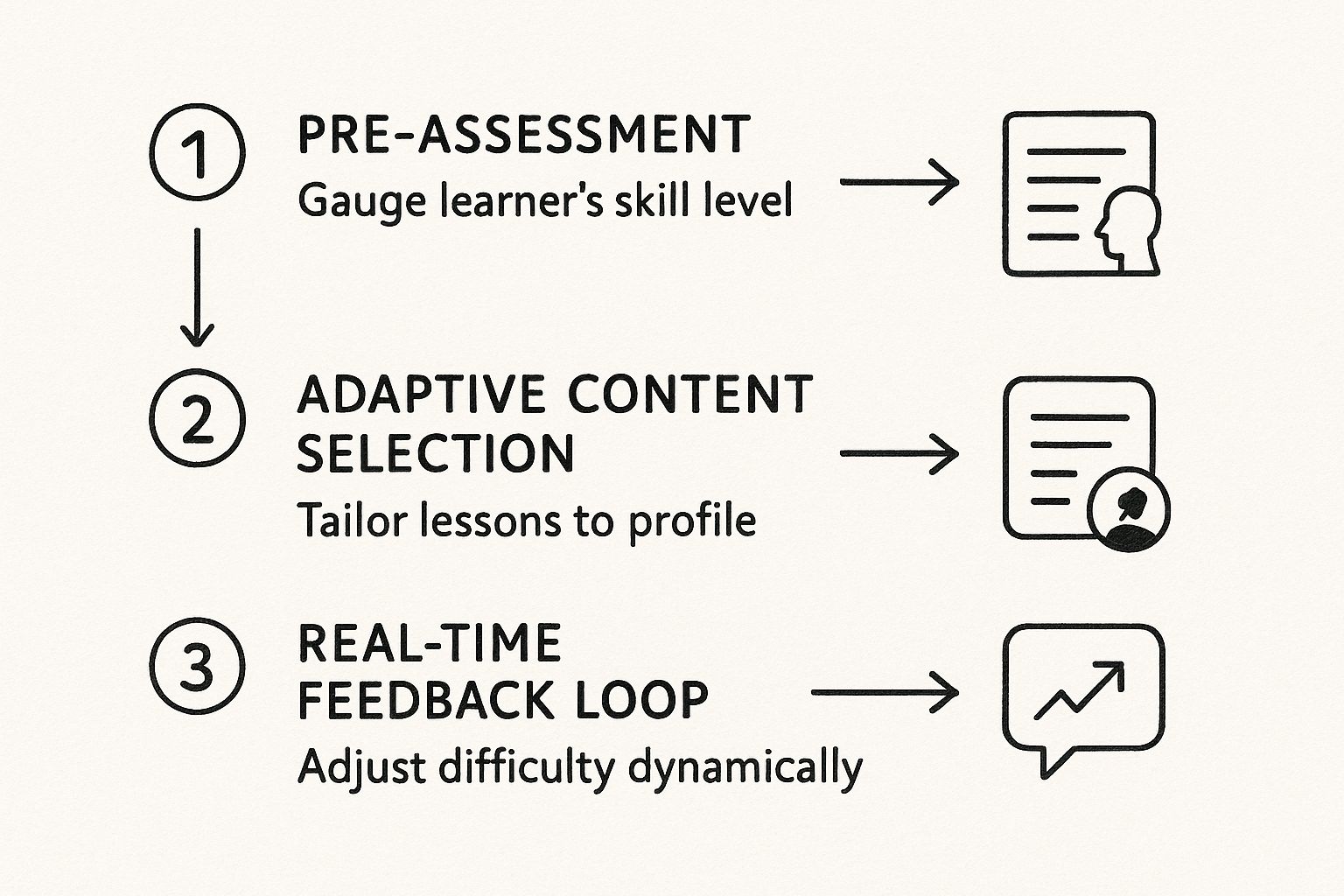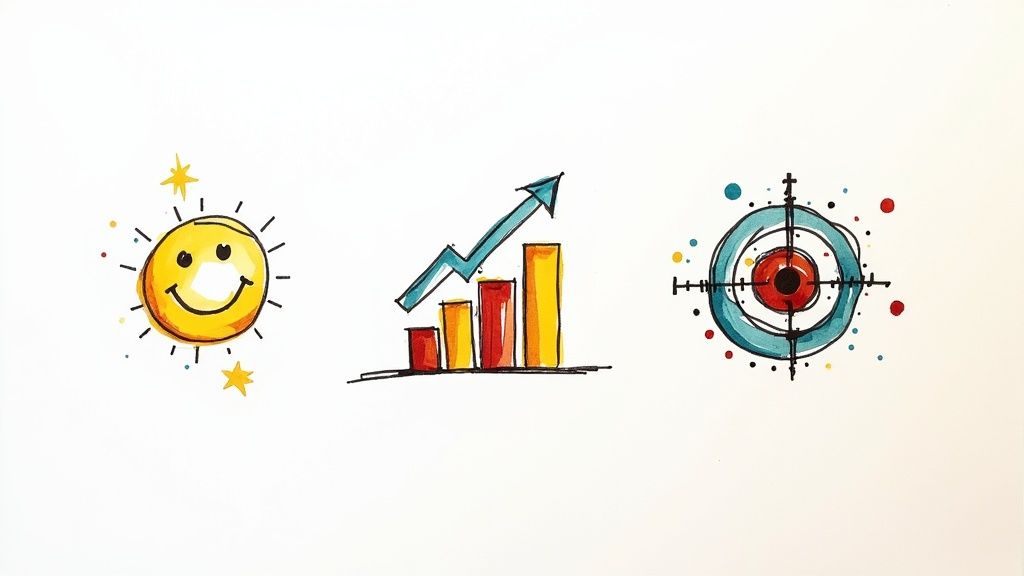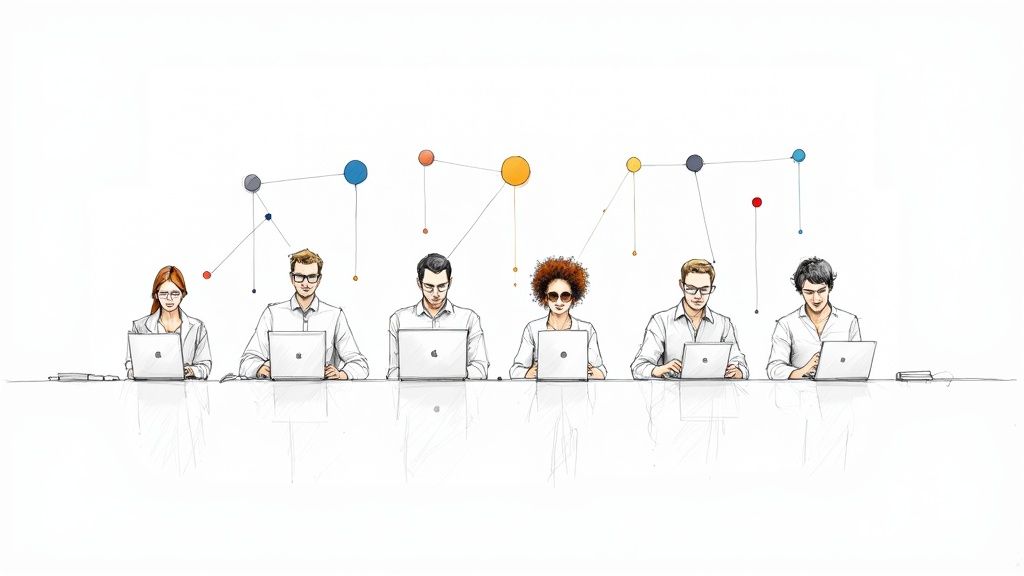
What is Adaptive Learning? Personalize Education with AI
Let's cut through the jargon and get straight to it: what is adaptive learning, really?
Imagine a personal tutor who knows you inside and out. They know exactly when you're getting stuck, when you're bored, and when you're ready for a bigger challenge, tweaking the lesson plan on the fly. That's the heart of adaptive learning—a way of teaching that uses smart technology, like AI, to craft a completely unique educational path for every single person.
Defining Adaptive Learning Without The Fluff

Forget the old one-size-fits-all curriculum. Adaptive systems are different. They actively watch how you're doing, figure out where your knowledge gaps are, celebrate your strengths, and serve up just the right content at just the right time. This isn't just about dumping textbooks online; it’s about creating a living, breathing learning environment that feels personal and actually works.
Think of it this way: traditional education is like a city bus. Everyone gets on, follows the same route, and gets off at the same stops, all at the same speed. Adaptive learning is more like a personal GPS. It maps out the best route just for you, rerouting you around traffic jams (tough concepts) and pointing out shortcuts when you're cruising (mastering material quickly).
The table below breaks down just how different these two approaches are.
Traditional Learning vs Adaptive Learning
It's clear that the goal of adaptive learning is to move away from the rigid structure of the past and toward a more flexible, responsive model that puts the learner first.
How Does It Actually Work?
At its core, adaptive learning runs on a constant feedback loop. The system gives you some information, asks you questions or assigns a task to see if you get it, and then uses your answers to decide what to show you next. For a deep dive into the specific tools that make this happen, this guide on adaptive learning software is a great resource.
This back-and-forth process delivers some major wins:
- Personalized Pacing: You can breeze through stuff you already know and spend extra time on the tricky parts. This cuts down on both boredom and frustration.
- Targeted Support: The system automatically flags your weak spots and gives you extra material to help you catch up without ever feeling left behind.
- Keeps You Hooked: When the content is perfectly matched to your skill level—not too hard, not too easy—it’s naturally more engaging.
The global shift toward personalized education isn't just a fleeting trend; it’s a massive market movement, reflecting a huge demand for smarter, more effective training in both schools and businesses.
The numbers don't lie. The adaptive learning market, recently valued at USD 4.84 billion, is expected to skyrocket to USD 28.36 billion by 2033. That’s a staggering compound annual growth rate of 19.7%, fueled by better AI and the global move to online learning. You can dig into the data and learn more about the industry's rapid expansion from IMARC Group's research.
How the Technology Behind Adaptive Learning Works
So, how does this digital tutor actually get to know you and craft a custom-fit experience? The real power behind adaptive learning isn't magic; it’s a surprisingly straightforward process. Think of it as a smart, continuous feedback loop powered by data and some clever algorithms.
This whole operation runs on a simple, three-part cycle: gather, analyze, and adapt. The system is always watching, learning, and tweaking things to make sure you're on the most efficient path forward. It’s less of a one-way street and more of a dynamic conversation between you and the platform.
The Core Feedback Loop
First up, the system gathers data on every single thing you do. This includes your quiz answers, sure, but also how long you spend on a video, which questions make you pause, and even the concepts you keep going back to. Every click is a clue.
Next, artificial intelligence and machine learning algorithms sift through all this information. They’re looking for patterns to build a unique profile of your strengths, weaknesses, and preferred pace. Some systems even consider individual learning styles to really dial in the engagement and make sure concepts stick.
Finally, the system uses this profile to adjust your learning journey on the fly. If you’re getting stuck, it might offer up a foundational article or a quick explainer video. Cruising along? It could toss a more challenging problem your way to keep you on your toes.
This isn't a one-time setup. It's a constant, real-time process. The system gets smarter about you with every interaction, making your learning path more accurate and effective over time.
This diagram really helps visualize how these steps flow together to create that personalized educational experience.

As you can see, it all kicks off with an assessment, which informs the content you see. That’s all powered by the continuous feedback loop making adjustments in real-time.
Key Technological Components
While the idea is simple, a few key pieces have to work together behind the scenes. To really get what makes adaptive learning tick, you need to know about these crucial parts.
The main engines driving this personalization are:
- Data Models: These are basically the blueprints for the course content. The system needs to understand how concepts connect—for example, that you need to nail addition before you can tackle multiplication.
- Instructional Models: This is the decision-maker. Based on how you're doing, it picks the very next piece of content to show you, all based on proven teaching rules.
- Learner Models: This is your living, breathing profile. It stores everything the system learns about your skills, knowledge gaps, and progress. It gets more detailed and accurate with every single lesson.
When these elements come together, they create a responsive environment where the curriculum isn't set in stone. Instead, it’s fluid, always shifting to meet you exactly where you are in your learning journey.
The Real-World Benefits for Learners and Educators

The rapid move toward adaptive learning isn't just about chasing the latest tech trend. Schools and businesses are embracing these platforms because they deliver real, tangible results for everyone involved. At its core, this shift finally tackles a fundamental challenge: how to teach a group of people who all learn at their own pace and in their own way.
For learners, the most powerful benefit is the end of the "one-size-fits-all" classroom. Students no longer have to feel bored by material they’ve already mastered or, worse, get left behind by concepts that are moving too fast. Instead, they stay right in their sweet spot, building confidence and momentum. This leads to much deeper engagement and, ultimately, better knowledge retention.
By tailoring the journey to the individual, adaptive learning ensures that a student's time is spent exactly where it's needed most—either reinforcing a weak area or accelerating through familiar topics. This creates a more efficient and less stressful educational experience.
This personalized approach is exactly why the technology is seeing such explosive growth. The adaptive learning market was recently valued at USD 3.7 billion and is on track to hit USD 9.2 billion by 2033. This surge shows just how effectively these AI-powered platforms are boosting learner engagement. You can dig into the numbers yourself in the full adaptive learning market outlook from MarketResearch.com.
Empowering Educators with Data
For teachers, adaptive platforms are a genuine game-changer. Think about the massive, time-consuming task of differentiation—creating multiple lesson plans to meet a classroom of diverse needs. Adaptive learning automates much of that work. This frees up instructors to do what they do best: provide high-impact, one-on-one support and mentorship.
Instead of guessing where students are getting tripped up, teachers get access to clear, powerful data dashboards. These analytics show exactly which concepts are causing trouble for specific students or even the whole class. This allows for quick, targeted interventions that fix knowledge gaps before they turn into major roadblocks.
Transforming Corporate Training
These benefits aren't just for K-12 or higher education; they're making a huge impact in the corporate world, too. When it comes to professional development and employee training, adaptive learning creates a much smarter path to upskilling.
- Accelerated Skill Development: Employees who already know the basics can fly past introductory modules, focusing their time on acquiring the new, critical skills they actually need.
- Reduced Training Time: By personalizing the content, companies can slash the hours spent in training without compromising on comprehension.
- Improved ROI: More efficient training means employees get back to their roles faster, armed with the knowledge to perform better. That’s a clear and direct return on investment.
A lot of businesses are finding that adding interactive video for training is a perfect partner to an adaptive strategy, helping to boost engagement and measure what employees are actually learning.
Seeing Adaptive Learning in Action
Theory is one thing, but what does adaptive learning actually look like when you’re the one using it? The best way to get a feel for its power is to see it through the eyes of a learner. Let's walk through a few real-world scenarios where this approach is making a huge difference.
Picture this: you're learning Spanish with a language app. After a quick placement quiz, the app figures out you've got basic greetings down but are fumbling with verb conjugations. Instead of boring you with "Hola" and "Gracias" all over again, it skips right ahead to practicing "-ar" verbs.
As you work through the exercises, the app is quietly tracking your every move. Nail five verb questions in a row? It decides you’re ready for a bigger challenge and introduces irregular verbs. But if you get a couple wrong, it pumps the brakes. It might show you a quick video tutorial on verb endings before serving up a different set of practice problems to make sure the concept sticks. This isn’t a pre-canned lesson; it’s a living conversation between you and the software.
From the Classroom to the Office
Now, let's step into a K-12 classroom. A middle schooler named Alex is using an online math program for algebra. The platform quickly sees that Alex is blazing through linear equations but hits a wall every time factoring polynomials comes up.
The system steps in automatically. It gives Alex a step-by-step interactive tutorial on factoring, then follows up with targeted practice problems that slowly ramp up in difficulty. At the same time, the teacher gets a quiet alert on their dashboard, flagging exactly where Alex is struggling. The next day, the teacher can pull Alex aside for a quick one-on-one, armed with precise data about the root of the confusion.
This is what changes the game. Instead of a one-size-fits-all worksheet, every student gets a personalized gauntlet of challenges and support. Homework suddenly becomes a genuinely productive practice session.
Finally, think about corporate training. A huge company needs to get everyone through its annual data security compliance course. A veteran manager, who's done this training for 10 years, can "test out" of the basics with a pre-assessment. Her learning path shrinks to just 15 minutes, focusing only on the newest policy updates.
Meanwhile, a new hire who bombs the pre-assessment is guided through the full, in-depth course. The system makes sure he truly understands each critical point before he can move on. This respects the time of experienced employees while guaranteeing that new team members build the solid foundation they need.
These are just a handful of the ways adaptive learning shows up in the real world. For a deeper dive into more scenarios across education and business, you can check out this great collection of adaptive learning examples that really highlights its versatility. The core idea is always the same: the technology carves out a more effective, efficient, and engaging path by responding to the individual.
Navigating the Challenges of Implementation

Adopting any powerful new technology has its share of hurdles, and adaptive learning is no exception. While the payoff is huge, getting there requires a clear-eyed look at the potential obstacles. Let’s be real: moving from a traditional, one-size-fits-all model to a dynamic, data-driven one is a major shift. It's about a lot more than just buying some new software.
First up is the initial investment. Top-tier adaptive learning platforms are sophisticated systems, and they do require a financial commitment. But the real work? That's in the content. For the AI to do its magic and personalize learning paths, it needs a deep, rich library of content that's been properly structured and tagged. This means organizations have to dedicate serious time and resources to either creating or curating materials the system can actually understand and use.
Overcoming Technical and Human Hurdles
Once you're past the initial setup, a few other critical challenges need careful management. They usually fall into two buckets: the technical stuff and the people who will be using it. You absolutely have to address both for a smooth transition and long-term success.
Here are the key implementation challenges to keep on your radar:
- Content Creation: This is a big one. You need a massive amount of modular content to fuel all those potential learning paths. It's a heavy lift that requires subject matter experts and instructional designers to completely rethink how they structure educational material.
- Data Privacy: These platforms collect a ton of data on how learners are doing. Setting up bulletproof data privacy and security protocols isn't just a good idea—it's an ethical must-have to protect sensitive information.
- Teacher and Trainer Buy-In: The human element is arguably the most important piece of the puzzle. You have to get educators and trainers on board from day one. They need solid training not just on the platform's nuts and bolts, but on how to shift their own role from being a lecturer to more of a facilitator.
The goal is to ensure the technology empowers educators with actionable insights, not overwhelms them with data or complexity. Without genuine buy-in and proper support, even the most advanced platform will struggle to gain traction.
Ultimately, a successful rollout of adaptive learning comes down to having a solid strategic plan. It’s a balancing act between the excitement for personalized education and a realistic view of the effort involved. The organizations that see these challenges coming—from content development to teacher training—are the ones best positioned to unlock the true potential of this powerful approach, making sure the technology actually serves the people using it.
The Future of Truly Personalized Education
While the adaptive systems we have today are already impressive, we’re really just scratching the surface of what’s possible. The future of adaptive learning is heading toward a world where education isn't a one-size-fits-all product but a deeply personal, continuously evolving service for every single learner. The next wave of innovation is set to make learning feel even more intuitive and effective.
We're already seeing emerging trends that blend immersive technologies like Virtual Reality (VR) and Augmented Reality (AR) directly into the learning experience. Just imagine a medical student practicing a tricky surgical procedure in a completely safe, adaptive simulation. As their skills sharpen, the simulation gets tougher. This is the kind of hands-on, risk-free practice that’s right around the corner.
The Dawn of Hyper-Personalization
Looking beyond immersive tech, the next big frontier is hyper-personalization. This is where AI adapts not just to what you know, but to how you actually think and feel in the moment.
Future systems will be smart enough to adjust content based on your cognitive style, personal interests, and even your emotional state during a lesson. If the platform senses you're getting frustrated, it might pivot to a different teaching method or even offer a quick motivational break to help you reset.
This evolution from personalized content to a truly personalized experience is where adaptive learning will deliver its greatest impact, creating environments that are as supportive as they are challenging.
This move toward hyper-personalization is the key to creating genuinely effective personalized learning pathways, making sure every single part of the educational journey is fine-tuned for the individual.
The financial world is definitely taking notice. One recent analysis valued the adaptive learning market at USD 3.76 billion and projects it will skyrocket to USD 30.79 billion by 2034. That's fueled by a massive 23.4% compound annual growth rate. This bullish forecast shows just how essential these technologies are becoming, especially as remote education solidifies its place in our world. You can dig into the full market forecast from Expert Market Research to see the numbers behind this incredible expansion.
Frequently Asked Questions About Adaptive Learning
As you start digging into adaptive learning, a few questions always seem to surface. Getting those answered is key to understanding how this all works in the real world. Let's run through a few of the most common ones we hear.
How Is This Different From a Standard Online Course?
Think of a standard online course as a digital textbook. Everyone gets the same pages, in the same order, at the same time. It's a static, one-size-fits-all approach.
Adaptive learning, on the other hand, is more like a dynamic conversation with a personal tutor. It's constantly listening to how you're doing, figuring out where you're struggling, and adjusting the material on the fly. It might serve up an easier question, a helpful video, or skip a topic you've already mastered.
The core difference is personalization. A standard course is a fixed highway for everyone, while an adaptive course builds a custom road for each individual learner.
Is Adaptive Learning Effective for Creative Subjects?
This is a great question. While adaptive learning shines in subjects with clear right-or-wrong answers—think math, science, or compliance training—its role in creative fields like writing or design is a bit different.
An adaptive system isn't going to grade your short story on its narrative arc (at least, not yet!). Instead, it focuses on the building blocks. For a writer, it might serve up targeted exercises on grammar, sentence structure, or vocabulary. This strengthens the technical foundation, freeing up the human instructor to mentor students on the more subjective, creative aspects of their work.
What Are the First Steps to Get Started?
For any school or organization looking to jump in, the first step isn't buying software—it's building a strategy.
- Define Clear Goals: Start with the "why." Are you trying to boost test scores, get new hires up to speed faster, or just keep learners more engaged? Be specific.
- Assess Your Content: Take a look at what you already have. Can your existing digital materials be repurposed for an adaptive environment, or will you need to create new content from scratch?
- Start Small: Don't try to boil the ocean. Kick things off with a pilot program for a single course or department. This is your chance to test the platform, get real feedback, and show some early wins before going all-in.
Transform your passive video content into active learning experiences with Mindstamp. Our interactive video platform helps you build engaging, personalized pathways that boost comprehension and provide deep analytics. Learn how Mindstamp can elevate your training and marketing today.
Get Started Now
Mindstamp is easy to use, incredibly capable, and supported by an amazing team. Join us!



Try Mindstamp Free










